In all, there are 31 different species of turtles in Mississippi, and there are 5 Sea turtles that can be viewed in the Gulf of Mexico if you’re lucky.
Mississippi has a huge variety of turtles. You can find small Musk and Mud turtles, terrestrial Box turtles and Gopher tortoises, giant Alligator Snapping turtles, and you could see a range of Sea turtles off the coast.
With that in mind, you can use this guide to try and find all the turtles Mississippi has to offer, or glean information about your next pet. When looking for a pet turtle though, please don’t take them from their natural habitat.
Wild turtles don’t do well when they are confined and placed in captivity. Even if you give them the best of care and a wonderful environment, wild turtles stress out very easily, and will not live very long.
Try to adopt a turtle from a reptile rescue or shelter, or find an upstanding breeder to get your pet. Captive bred turtles are used to human contact and will live a happier, healthier life.
Now, let’s go on an adventure and find out all about Mississippi’s turtle species.
Table of Contents
Box Turtles in Mississippi
1. Eastern Box Turtle

- Experience Level: Beginner
- Family: Emydidae
- Scientific Name: Terrapene carolina carolina
- Other Names: Land Turtle
- Adult Size: 4 to 7 inches
- Life Span: 50 to 100 years
- Average Price Range: $260 – $360
- Conservation Status: Michigan, New Hampshire, Massachusetts, and Connecticut—list the animal as a species of special concern, and Maine lists the turtle as endangered.
Eastern Box turtles are terrestrial and don’t swim well. They can occasionally go in the water, but they prefer to stay on land for the majority of their lives. You can find these little turtles in forests, and other damp areas with water such as small streams nearby.
Box turtles have hinged lower shells (plastrons) that allow them to withdraw tightly into their shell for protection. The upper shell (carapace) is dark brown or olive and has either yellow, orange, or red patterns on each scute. Scutes are the individual growth plates on a turtle’s upper and lower shells.
The plastron, aside from having 2 hinges, is pale colored with various degrees of dark brown or black smudges.
Their exposed skin and scales are usually the same colors as their carapace. They will be mostly olive, dark brown, or nearly black with yellow or orange speckles and blotches.
Eastern Box turtles range widely in their search for food, but they tend to come back to the area they hatched from. They are scavenging omnivores that eat berries and fruits, mushrooms, some plants, worms, caterpillars, insects, spiders, and even carrion.
2. Gulf Coast Box Turtle

- Experience Level: Expert
- Family: Emydidae
- Scientific Name: Terrapene carolina major
- Other Names: N/A
- Adult Size: 6 to 8.5 inches
- Lifespan: 30 to 40 years in captivity, but over 100 years in the wild
- Average Price Range: $230 to $450
- Conservation Status: Vulnerable
Gulf Coast Box turtles are the largest species, growing over 8 inches long. These turtles are generally very dark. Their shells and skin tend to be dark brown or black with a varying degree of yellow or orange spots and short stripes.
Their skin is very dark colored too, with patches and patterns of yellow or orange. Some may only have small spots of color, while others may have large swaths of yellow or orange covering their limbs or heads.
Like other Box turtles, this one will spend the majority of its life on land, but they do like to be very near slow-moving or stagnant water. This helps to maintain the humidity levels they need and allows them to hunt for a wide variety of insects.
If you are looking to get this species of turtle as a pet, know that they require a lot of care and need a very particular type of habitat. They are not easy to care for properly.
In the wild, Gulf Coast Box turtles are thought to live for over 100 years, but in captivity, that number plummets to a few decades. It’s thought that stress and lack of natural habitat lead to a shorter lifespan.
While this species of turtle is omnivorous, they eat a lot of insects. One of the reasons they like to stay near swamps and marshes is because of the abundance of insects around these waters. Aside from bugs, the Gulf Coast Box turtle feeds on mushrooms, moss, berries, and fruit.
3. Three Toed Box Turtle
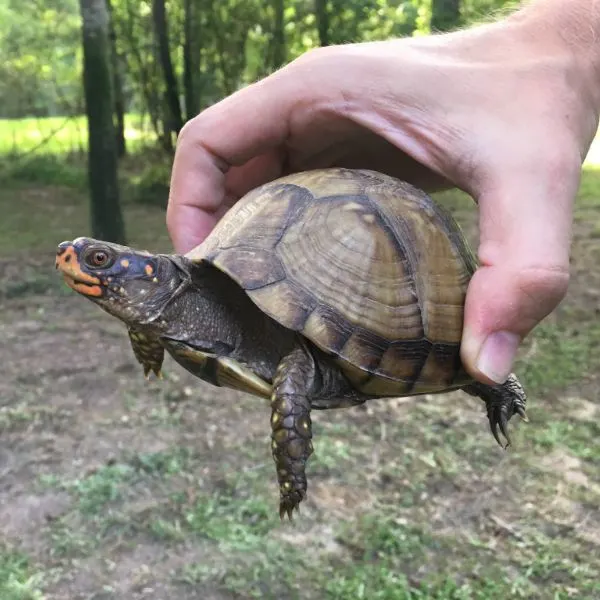
- Experience level: Intermediate
- Family: Emydidae
- Scientific Name: Terrapene carolina triunguis
- Other Names: N/A
- Average Adult Size: 4.5 – 6.5 inches
- Life Span: 70+ years
- Average Price Range: $140 – $430
- Conservation Status: Vulnerable
As their name suggests, this Box turtle has 3 toes on the hind legs, though some may have 4, leading to some confusion. To further identify this turtle, look for a lighter carapace with colors ranging from light brown or tan to olive. They may have some markings similar to the Eastern Box turtle, or their upper shell will be one solid color.
Their skin is similar to their shell colors and is not as brightly colored as other species.
Unlike other species of box turtles, the Three Toed Box turtle can withstand drier areas such as meadows and grasslands. They still need water, but can be found far away from a water source.
These turtles are also omnivores that will eat nearly any kind of insect, spider, or bug. They will also feed on worms, fungi, fruits and berries, and occasional carrion.
Chicken Turtles in Mississippi
4. Eastern Chicken Turtle

- Experience level: Beginner
- Family: Emydidae
- Scientific Name: Deirochelys reticularia
- Other Names: N/A
- Average Adult Size: 6.5 – 10 inches
- Life Span: 13 – 20 years
- Average Price Range: $150 – $300
- Conservation Status: Threatened
Chicken turtles are often mistaken for Painted turtles, but with careful observation, you can tell the difference. While both species have striped skin, the Chicken turtle has an egg shaped shell when noticed from above, and they have a distinct net-like pattern on the carapace.
Chicken turtles also have very long necks that can stretch nearly as long as the carapace. The plastron on Eastern Chicken turtles is yellowish colored with a dark pattern or black smudge on it, while the carapace has a yellowish rim.
You’ll find these turtles in ponds, marshes, oxbow lakes, and swamps with slow to no currents. They can spend as much time in the water as on land. When their aquatic habitat dries up, they won’t search for a new place to live, instead, they burrow in the mud and stay there until the water comes back.
5. Western Chicken Turtle

- Experience Level: Intermediate
- Family: Emydidae
- Scientific Name: Deirochelys Reticularia Miaria
- Other Names: N/A
- Adult Size: Between 6 and 8 inches
- Lifespan: Between 15 and 30 years
- Average Price Range: Between $180 and $300
- Conservation Status: Endangered in Missouri, considered secure nationally
The Western Chicken turtle is slightly smaller than the Eastern variety, but they still have a very long neck and a similar carapace pattern. The stripes on the skin of the Western Chicken turtle are pale yellow or white. They are much lighter than other Chicken turtle subspecies.
The plastron on these turtles had a pattern in the middle, instead of the outer edge.
Western Chicken turtles inhabit larger bodies of water including the Mississippi river, but all Chicken turtle species are mostly carnivorous. They feed on insects, and insect larvae, as well as fish, the occasional tadpole, and rarely, some types of vegetation.
Cooters in Mississippi
6. Alabama Red-belly Turtle

- Experience level: Intermediate
- Family: Emydidae
- Scientific Name: Pseudemys Alabamensis
- Common Name: Alabama red-bellied turtle, cooter, red-belly, slider
- Average Adult Size: 10 – 14 inches
- Life Span: 40 – 60 years
- Average Price Range: Approximately $50 to $150
- Conservation Status: Endangered
Alabama Red-belly turtles are only found in a few places in Alabama, and Mississippi. They live along the Mississippi river in fresh, and occasionally brackish waters. They prefer a habitat with plenty of aquatic vegetation and sandy bottoms.
They have a dark green, patterned carapace with a wide bridge between the upper and lower shell. The bottom of the shell can be red, as its name suggests, but it can also be yellow or orange. Whatever the color though, they all have a darker colored pattern.
Their skin is olive, brown, or black with yellow stripes.
These turtles are highly aquatic and rarely leave the water except to bask in the sun or search for proper nesting sites.
They love aquatic habitats because they are predominantly herbivores.
7. Eastern River Cooter

- Experience Level: Beginner to Intermediate
- Family: Emydidae
- Scientific Name: Pseudemys concinna concinna
- Other Names: River Cooter
- Adult Size: Between 8 and 12 inches
- Life Span: Between 20 and 40 years
- Average Price Range: $20 to $50
- Conservation Status: Special concern
Eastern River Cooters are freshwater turtles with wide shells and seemingly small heads. They have shells that are dark in color but have bright, distinctive patterns along the top. The plastron on these turtles is typically yellow and may have dark borders along the outer scutes.
The head, neck, and limbs of these turtles are dark brown to black with bright yellow stripes. One of the identifying marks is a yellow Y-shape that appears on the side of the head of these turtles.
Eastern River Cooters prefer waters with a strong current and plenty of underwater vegetation. While they do love to bask, they will quietly slide into the murky waters at the first sign of any disturbance.
Eastern River Cooters are herbivores that eat algae, fruits, and plants.
Terrapins in Mississippi
8. Mississippi Diamondback Terrapins

- Experience level: Intermediate to Expert
- Family: Emydidae
- Scientific Name: Malaclemys terrapin pileata
- Other Names: Mississippi Diamondback Terrapin, Diamondback Terrapin
- Average Adult Size: 5.5 – 8 inches
- Life Span: 25 – 40 years
- Average Price Range: $300 to $1,000 It’s illegal to own Diamondback terrapins in some states, while you need a special permit to own them in other states, including Alabama.
- Conservation Status: Endangered
The Diamondback Terrapin is the only turtle that lives in brackish waters full time. Other turtles can stay in the slightly salty water for shorter periods, but they have to return to freshwater sooner or later.
You can find these beautiful turtles in coastal estuaries, tidal pools, salt marshes, and other areas where freshwater meets saltwater.
They get their name from the diamond-shaped, wedged carapace. Even without looking for the gem shaped shell, you can instantly recognize them from the dark rings, light grey, to brown shell, and greyish to white skin. Their heads, necks, and limbs also have dark spots or blotches.
These turtles feed mostly on crustaceans, mollusks, and insects. They will occasionally eat some vegetation. Their favorite foods are crabs, and they will sometimes follow this food source into crab pots where they too become trapped and drown.
Legislation is being introduced to help save these turtles from death in crab pots. Crabbers are supposed to alter the traps in a way that would allow the turtles to escape if they accidentally got stuck in these traps.
Map Turtles in Mississippi
9. Alabama Map Turtle

- Experience level: Beginner
- Family: Emydidae
- Scientific Name: Graptemys pulchra
- Common Name: Sawback, Alabama Map Turtle
- Average Adult Size: 5 – 11 inches
- Life Span: 15 – 20 years
- Average Price Range: Approximately $50-150
- Conservation Status: Near threatened
Alabama Map turtles are found in Alabama, Georgia, and Mississippi. They are larger turtles with an olive shell with lighter colored markings on the carapace. There is a pronounced black keel that runs from the front to the back on these turtles.
This keel fades as the turtle ages, especially in the larger female. Most map turtle species look very similar to each other and can only be identified by small characteristics. A distinguishing pattern that sets these turtles apart from other map turtles is the partial “mask” on the face and head.
Most Map turtle species feed on insects, crustaceans, mollusks, and crustaceans. This subspecies tends to feed mostly on an introduced oriental mussel. Smaller males and juveniles feed on insects, snails and small clams, and crustaceans.
10. Black Knobbed Map Turtle

- Experience level: Beginner
- Family: Emydidae
- Scientific Name: Graptemys Nigrinoda spp.
- Other Names: Black Knobbed Sawback, Sawback turtle
- Average Adult Size: 5 – 10 inches
- Life Span: 20 – 30 years
- Average Price Range: $150 to $250
- Conservation Status: Near threatened
The Black Knobbed Map turtle is easy to identify because of the high, black knobs that stick up from the carapace. They also have yellowish rings on their scutes that help identify them. Without these protrusions and rings, they look much like other subspecies of Map turtles.
They have dark colored skin with yellow to white stripes on their heads, necks, and limbs.
In Mississippi, you can find these turtles in the Pearl River, and the same habitat as the Alabama Map turtle.
Like their cousins, the Black Knobbed Map turtle loves to bask. They can be found on the edge of the river, on fallen logs, or on other areas sticking out of the water. When they sense danger though, they quickly return to the safety of the river.
Black Knobbed Map turtles are omnivorous. They will feed on insects, fish, crayfish, mollusks, algae, and vegetation.
11. Mississippi Map Turtle

- Experience level: Intermediate – expert
- Family: Emydidae
- Scientific Name: Graptemys pseudogeographica kohni
- Other Names: Sawback Turtle
- Average Adult Size: 5 – 10 inches
- Life Span: 30 – 50 years
- Average Price Range: $30 – $130
- Conservation Status: Least Concern
Mississippi Map turtles are found all along the Mighty Mississippi River, as far north as Illinois. They have the same basic characteristics as other species of Map turtles. The way to tell these from other species is the crescent shaped stripes that curve under this turtle’s eyes.
You’ll also notice that there is no line running through the iris on Mississippi Map turtles.
Mississippi Map turtles are very aquatic. They will emerge from the water to bask on rocky outcroppings, and females will go on land to find nesting sites for their eggs, but other than that, they stay in the water.
These turtles are mostly carnivorous, feeding on crayfish, small freshwater clams and mussels, insects and larvae, fish, and very little aquatic vegetation.
12. Northern Map Turtle

- Experience Level: Beginner
- Family: Emydidae
- Scientific Name: Graptemys geographica
- Other Name: Common map turtle
- Adult Size: Between 4 and 10 ½ inches
- Life Span: 15 to 20 years
- Average price range: Between $20 and $60
- Conservation Status: Least concern
The Northern Map turtle is the most abundant subspecies of Map turtle in the U. S. You’ll find these turtles in major rivers and fast-running streams. True to the species, this turtle also loves to bask, is an excellent swimmer, and is mostly carnivorous.
They have olive green to dark brown shells, with the central ridge on the top of their shells. They also have lighter colored swirls that resemble map contours and saw tooth serrations found in the back edge of the carapace.
To distinguish this turtle from other Map turtles, look for small spots or ovals behind the eyes among the many yellow or white stripes.
13. Ouachita Map Turtle

- Experience Level: Beginner
- Family: Emydidae
- Scientific Name: Graptemys ouachitensis
- Other Names: Southern Map turtle
- Adult Size: 3.5 to 10 inches (9 to 25.5 cm)
- Life Span: 15 to 20 years
- Average Price Range: $40 to $100
- Conservation Status: Least concern
Ouachita Map turtles are fond of swift currents and ample basking spots. Again, like other Map turtles, they will gather on quiet logs to soak in the sun, but will quickly hop into the water at the slightest disturbance. If you want to see them, you’ll have to bring along some powerful binoculars.
If you’re able to get close enough to inspect an Ouachita Map turtle, look for rectangular markings behind the eyes, and a small spot on the underside of the eye.
Ouachita Map turtles have a highly patterned plastron, whereas the Northern Map turtle has a plain, pale looking underside.
These turtles are more omnivorous than some of their cousins. They will still eat crayfish, mollusks, mussels, insects, and the like, but they also feed on algae and vegetation.
14. Pascagoula Map Turtle

- Experience Level: Intermediate
- Family: Emydidae
- Scientific Name: Graptemys gibbonsi
- Other Names: Pascagoula Sawback
- Adult Size: 5 to 11.5 inches (12.5 to 29.5 cm)
- Lifespan: 30 to 50 years
- Average Price Range: N/A
- Conservation Status: Endangered
Once thought to inhabit the Pascagoula and the Pearl River, in 2010 the turtles found in the latter river were separated into a different species, the Pearl River Map turtle. The Pascagoula Map turtle is only found in this river in Mississippi and is named after the author, professor, and renowned herpetologist, Whit Gibbons (Graptemys Gibbonsi).
These Map turtles have a black ridge running along the middle of the carapace with small serrations. Their upper shell is olive to grey and more patterned along the edge or marginal scutes.
They have the same colored skin and stripes as others in the Graptemys classification, but the marks behind the eyes are large and curve around under the eye. They are omnivorous.
15. Pearl River Map Turtle

- Experience Level: Intermediate
- Family: Emydidae
- Scientific Name: Graptemys Pearlensis
- Other Names: N/A
- Adult Size: 3 to 5 inches (Males) and 8 to 10 inches (Females)
- Lifespan: Up to 30 years
- Average price range: Between $200 and $500
- Conservation Status: Endangered
As their name suggests, Pearl River Map turtles are endemic to that river, especially in the drainage area. They are considered endangered because their numbers are in decline and only found in such a small area.
Water pollution and a decline in native freshwater mussels are contributing factors to this turtle’s dwindling numbers.
They have an unbroken black ridge running down the middle of the carapace, and slight rear facing serrations.
On the top of their head is a large mass of yellow or white coloration that usually connects, instead of being two separate blotches.
Pearl River Map turtles are omnivorous, but mainly eat mussels and crustaceans.
16. Ringed Map Turtle
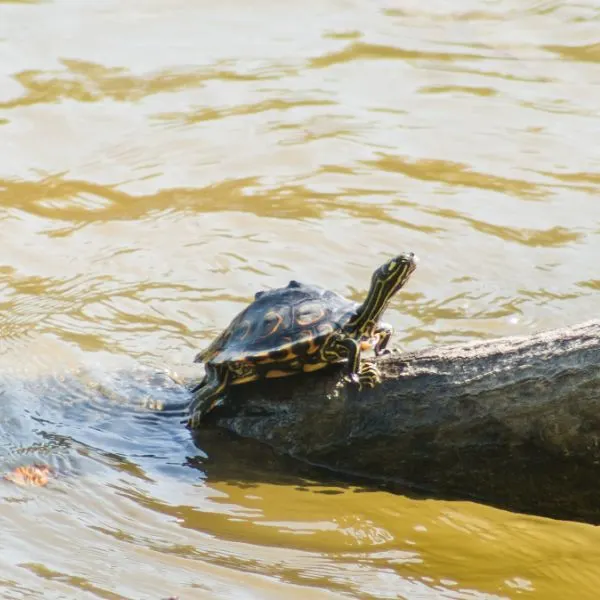
- Experience Level: Intermediate
- Family: Emydidae
- Scientific Name: Graptemys oculifera
- Other Names: N/A
- Adult Size: 4 to 7 inches
- Lifespan: Between 30 and 50 years
- Average price range: Between $700 and $1000
- Conservation Status: Threatened
These turtles are endangered and are federally protected in many states, meaning it’s illegal to keep them in certain states. Check your local reptile laws before purchasing these striking turtles to make sure.
Ringed Map turtles don’t have the map-like contours on their shells of other map turtles, instead, they have bright colored rings on their pointed carapace.
As they age the points, saw-toothed serrations, and bright colors start to fade, especially in females who get much bigger than males. In map turtles, females often grow twice as big as the boys.
Ringed Map turtles are omnivores that eat crayfish, mussels, freshwater clams, insects, and vegetation.
17. Yellow-blotched Map Turtle

- Experience Level: Intermediate
- Family: Emydidae
- Scientific Name: Graptemys flavimaculata
- Other Names: Yellow-blotched Sawback
- Adult Size: 3.5 to 7.5 inches
- Lifespan: 30 to 50 years
- Average Price Range: $350 to $1000
- Conservation Status: Threatened
Yellow-blotched Map turtles share a habitat with the Pascagoula River Map turtle. They are found nowhere else but this fast moving river.
You will recognize these turtles, if you’re lucky enough to catch sight of them, by the round, yellow spots all over the carapace. They also have a serrated keel that’s tipped in black, and serrations on the back of the shell.
They have dark skin with white to yellow stripes. When they are not basking on logs and brush piles near the bank, they are underwater searching for crustaceans, insects, mollusks, fish, and aquatic vegetation to eat.
Mud Turtles in Mississippi
18. Eastern Mud Turtle

- Experience Level: Beginner
- Family: Kinosternidae
- Scientific Name: Kinosternon subrubrum
- Other Names: Common mud turtle
- Adult Size: 3 to 4 inches
- Life Span: 40 to 50 years
- Average Price Range: $20 – $100
- Conservation Status: Least concern
Eastern Mud turtles have unpatterned, egg shaped shells in colors ranging from tan to dark brown. The head has grey to yellow spatters or stripes on dark brown to nearly black skin, while the limbs and other exposed skin are usually solid colored.
These turtles are at home in the water or on land, but they are found among slow moving waters such as swamps, bogs, marshes, and ponds with a lot of vegetation and soft bottoms. They aren’t great swimmers and tend to walk and scamper in the water instead of swimming.
Eastern Mud turtles don’t bask often, instead, they will wander around on land in search of food. When winter comes, these turtles will burrow into the mud to hibernate, sometimes over 200 feet away from water.
These little muddy turtles are omnivores that enjoy eating fish, snails, insects, crayfish, worms, and aquatic vegetation.
19. Mississippi Mud Turtle

- Experience level: Intermediate
- Family: Kinosternidae
- Scientific Name: Kinosternon subrubrum hippocrepis
- Other Names: N/A
- Average Adult Size: 5 – 7 inches
- Life Span: 25 – 45 years
- Average Price Range: $40 – $80
- Conservation Status: Least Concern
Mississippi Mud turtles are larger species of mud turtles, often reaching 7 to 8 inches long. They are a drab looking turtle with no discerning characteristics on their shells. They are light brown to nearly black, and often have algae growing on them.
There is a lighter, nearly yellow colored ridge on the outer edge of the carapace that leads to a yellowish, plain plastron. They have dark colored skin with two yellowish or white stripes along the side of the head.
Like other mud turtles, the Eastern Mud species prefers shallow bogs, swamps, and marshes. Here there’s plenty of mud to bury themselves in when it gets cold, lots of insects, worms, and mollusks to feed on, and vegetation to eat and hide among.
Musk Turtles in Mississippi
20. Eastern Musk Turtle
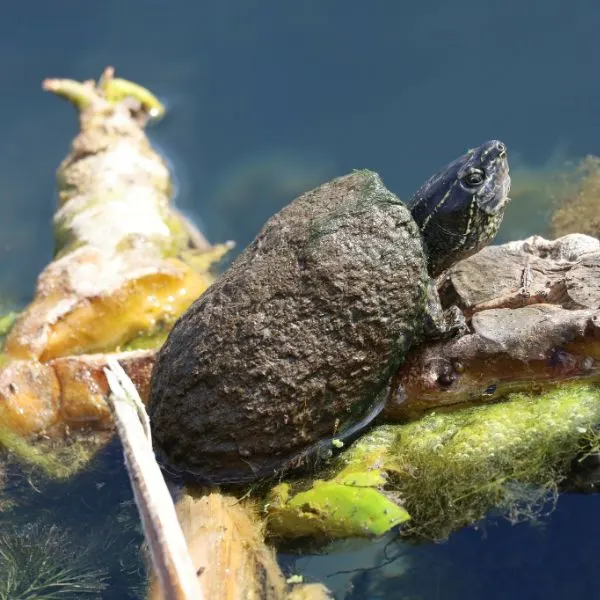
- Experience Level: Intermediate
- Family: Kinosternidae
- Scientific Name: Sternotherus odoratus
- Other Names: Common Musk turtle, Stinkpot
- Adult Size: 4 to 5 inches
- Life Span: 30 to 50 years
- Average Price Range: $30 to $120
- Conservation Status: Least concern
Musk turtles are the skunks of the turtle world. They have a pair of glands near their back legs that, when released, will assault your nose. When they feel threatened or bothered they can secrete their secret weapon, and if that doesn’t do the trick, they will also try to bite.
Mud turtles also have these glands, but the endearing term “Stinkpot” stuck to this species.
These turtles have similarly shaped shells as our previous entrants, oval shaped, with no patterns, dark, muddy, drab colored, and flattened on top.
The Eastern Musk turtle also has two white stripes running from the pointed snout to the back of the head, but they also have a pair of barbels on their chin.
These Musk turtles are mostly nocturnal and will run around at night feeding on crustaceans, insects, worms, fish, carrion, and plant matter.
21. Loggerhead Musk Turtle

- Experience level: Beginner
- Family: Kinosternidae
- Scientific Name: Sternotherus minor
- Common Name: Stripe head/loggerhead turtle
- Average Adult Size: 2 – 4 inches
- Life Span: 20 – 40 years
- Average Price Range: $50 – $200
- Conservation Status: Least Concern
Loggerhead Musk turtles are very small, even when fully grown, reaching a maximum length of 4 to 5 inches. They are most well known for their oversized head in relation to the overall size.
Their carapace is tan to dark brown and has black specks or spots. Juveniles tend to have three keels that all but disappear in adulthood. Another distinguishing characteristic is the overlapping vertebral scutes.
The head on these turtles is usually black or dark brown with lighter colored stripes and spots. Their plastron is small and offers very little protection.
Loggerhead Musk turtles like to live in ponds, wetlands, and other areas of water with very minor currents. They also look for muddy substrates and plenty of vegetation where they can hunt their favorite prey, crustaceans, and mollusks.
Their large heads let them crunch through hard shells on mussels, crayfish, clams, and snails. Juveniles feed more on insects and smaller snails until their jaw muscles become strong enough to crack through clam shells.
They also feed on algae, and some plant matter, but the majority of their diet comes from meat sources.
22. Razorback Musk Turtle

- Experience level: Beginner
- Family: Kinosternidae
- Scientific Name: Sternotherus Carinatus
- Other Names: Razor-Backed musk turtle, Mississippi Musk turtle
- Average Adult Size: 5 – 6 inches
- Life Span: 20 – 30 years
- Average Price Range: Approximately $80 – 160
- Conservation Status: Least Concern
Razorback Musk turtles have grey, olive, or nearly black colored carapaces with a pointed shell, and black outlined scutes. The upper ridge is serrated, and the vertebral scutes overlap each other, giving this turtle its name.
These turtles are almost entirely aquatic, only leaving the water to lay eggs, and bask on rare occasions. They inhabit ponds, swamps, and rivers with very slow currents. Abundant vegetation and soft substrates are also agreeable to this species.
They have light colored skin, from grey to brown, that is covered in numerous black spots.
Razorbacks are mostly carnivorous. They feed on fish, crustaceans, insects, mollusks, amphibians, clams, and carrion. Occasionally they have been known to eat some seeds, fruits, and a little bit of vegetation.
23. Stripe-necked Musk Turtle

- Experience level: Beginner
- Family: Kinosternidae
- Scientific Name: Sternotherus minor peltifer
- Other Names: Loggerhead Musk turtle, Stinkpot
- Average Adult Size: 3 – 5 inches
- Life Span: 30 to 50 years
- Average Price Range: $400 – $500
- Conservation Status: Threatened
As the name suggests, Stripe-necked Musk turtles have numerous stripes along the head and neck. The carapace on these turtles is tan to dark brown and has black spots scattered throughout, and black outlining the scutes.
Like the Loggerhead Musk turtle, the Stripe-necked turtle has an oversized head in relation to the rest of the body.
These turtles prefer waters with faster currents, clear water, and rocky bottoms. Here they hunt mainly for freshwater mussels. As water pollution quickly affects these filter-feeders, when their numbers drop, so do the Stripe-necked Musk turtle populations.
They also eat insects, crayfish, mollusks, and some vegetation, but the native mussels are their main food source.
Painted Turtles in Mississippi
24. Southern Painted Turtle
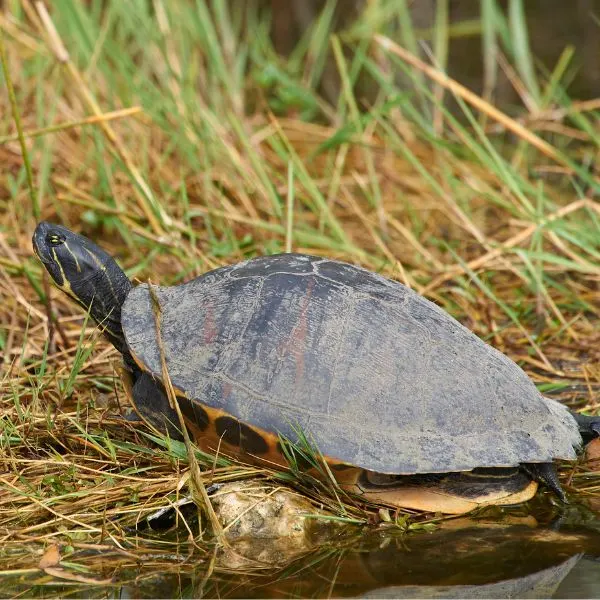
- Experience level: Beginner
- Family: Emydidae
- Scientific Name: Chrysemys dorsalis
- Other Names: Painted Turtle
- Average Adult Size: 4 – 6 inches
- Life Span: 20 – 25 years
- Average Price Range: $30 – $150
- Conservation Status: Least Concern
Southern Painted turtles are not only found throughout the state of Mississippi but from coast to coast. They inhabit major rivers as well as floodplains, and slow-moving marshes, ponds, and wetlands.
Southern Painted turtles are the smallest of the Painted turtle species, maxing out at around 6 inches in straight carapace length.
They have slightly domed, smooth shells with a red or orange stripe running along the middle. The exposed skin and scales are dark brown to black with yellow to red stripes.
These turtles love to bask on logs, outstretched tree limbs that drape in the water, or sandy banks.
These turtles are omnivorous, and will feed on vegetation mostly, but will also eat insects, snails, fish, and the occasional tadpole.
Pond Sliders in Mississippi
25. Red Eared Slider
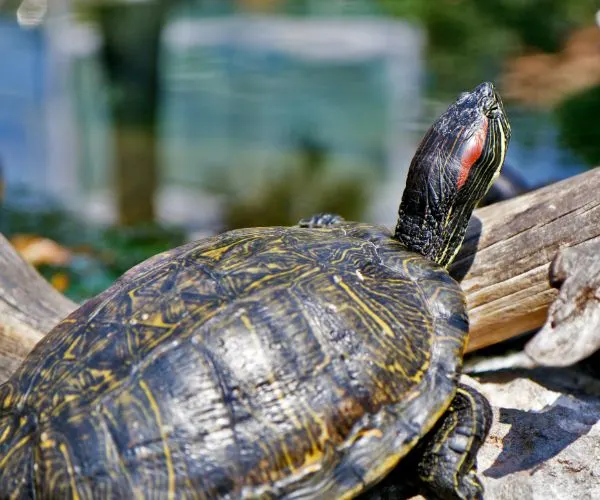
- Experience level: Beginner
- Family: Emydidae
- Scientific Name: Trachemys scripta elegans
- Common Name: Pond slider, Red-eared terrapin, Water slider
- Average Adult Size: 6 – 8 inches
- Life Span: 20 to 40 years
- Average Price Range: approximately $30 to $100
- Conservation Status: Least concern
Red Eared Sliders are the world’s most widespread turtle. They are found on nearly every continent except for Antarctica. These turtles are so abundant because when they get in the water it’s almost as if they multiply like Gremlins.
They prefer slow-moving waters and streams, but they can thrive in nearly any freshwater habitat. They are aggressive to other turtles and can eat nearly anything.
Red Eared Sliders are very cute for being so plucky, which may explain why they are such popular pets.
They have bright green to olive carapaces with yellow, orange, black, or dark green markings and a pale tan carapace with occasional brown smudges. Their skin is dark green to brown with yellow stripes, much like a Painted turtle.
Red ovals or thick stripes are found behind the eyes of these turtles, making it look like they have ears.
Long front claws adorn their front legs that males use to entice females into mating.
These turtles love to bask and eat. They are omnivores that will feed on plants, algae, fish, crayfish, insects, mollusks, worms, and much more.
26. Yellow Belly Slider
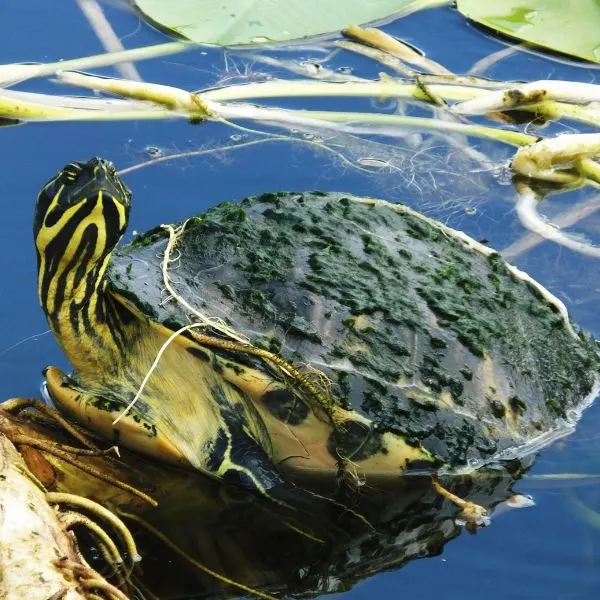
- Experience level: Beginner
- Family: Emydidae
- Scientific Name: Trachemys scripta scripta
- Other Names: Pond slider, Yellow slider
- Average Adult Size: 5 – 13 inches
- Life Span: 50 to 100 years
- Average Price Range: approximately $30 to $130
- Conservation Status: Least concern
Yellow Belly Sliders look very similar to Red Eared Sliders, except they don’t have the prominent red on their heads. Instead, they have wider yellow stripes on their heads, necks, and limbs. As the name implies, they have bright yellow plastrons that are all one color or are accompanied by a few black spots.
These turtles are another popular pet species as they are abundant, low priced, and beautiful because of all the bright colors.
Yellow Belly Sliders occupy rivers, lakes, oxbows, reservoirs, and large streams. Often you can find them stacked together and crowding basking spots.
Mostly herbivores, these turtles eat plenty of plants, seeds, roots, shoots, and berries as well as the occasional insect, small fish, or mollusk.
Snapping Turtles in Mississippi
27. Alligator Snapping Turtle

- Experience level: Expert
- Family: Chelydrida
- Scientific Name: Macrochelys temminckii
- Common Name: Loggerhead Snapper
- Average Adult Size: 13-30 inches
- Life Span: 30 – 50 years
- Average Price Range: Approximately $50 to $300
- Conservation Status: Threatened
These massive beasts are the largest freshwater turtle species in North America. The largest freshwater turtle in the world is the Yangtze Giant Softshell turtle which can reach lengths of over 39 inches and weigh over 200 pounds.
Alligator Snapping turtles don’t get quite that big, but they are still a shocking sight to behold. They have large, thick, spiked shells, hefty, muscular limbs covered in fleshy spikes, and huge, basketball sized heads.
In the water, these turtles are about as active as rocks. They lay in wait on the bottom with their mouths open, wiggling a fleshy tendril on their tongue that looks like a worm. When a frog, turtle, fish, or whatever comes to inspect, the turtle snaps down on it and eats it.
You don’t have to worry about coming across these turtles in the water because they will move away if you get close to them. But, like Common Snapping turtles, if you encounter them on land, leave them alone. They can and will become aggressive if someone gets too close.
Alligator snappers rarely ever bask, and only leave the water to lay eggs, or find a new watery habitat. Which they don’t do very often.
28. Common Snapping Turtle

- Experience level: Intermediate to Expert
- Family: Chelydrida
- Scientific Name: Chelydra Serpentina
- Other Names: Snapping Turtle, Snapper, Eastern Snapping Turtle
- Average Adult Size: 8 to 20 inches
- Life Span: 30 – 50 years
- Average Price Range: Approximately $40 to $120
- Conservation Status: Least concern
Common Snapping turtles get quite large as well, but they don’t look quite as fearsome as the Alligator Snapper. These turtles have dark brown shells, with minor ridges, and a white, small, cross-shaped plastron.
They have very long necks, wide, hook shaped beaks, long limbs, and thick claws. They also have a very long tail with dinosaur-like spikes.
These turtles like to hang out at the bottom of the water and wait for prey to come to them. They inhabit lakes, large, slow-moving rivers, swamps, and reservoirs, typically with vegetation and sandy, muddy substrate to hide among.
While in the water they are placid and easygoing, once they are on land they will become aggressive. If a loud hiss doesn’t keep you away, a very painful bite will let you know, this turtle isn’t playing around.
Common Snapping turtles leave the water to find proper nesting sites, and to find different habitats. Some will travel long distances between homes. When you see them out of the water, it’s best to simply leave them alone.
Snappers are mostly carnivorous, feeding on fish, amphibians, crayfish, insects, mollusks, and worms, but they will also feed on algae and vegetation.
Softshell Turtles in Mississippi
29. Gulf Coast Smooth Softshell
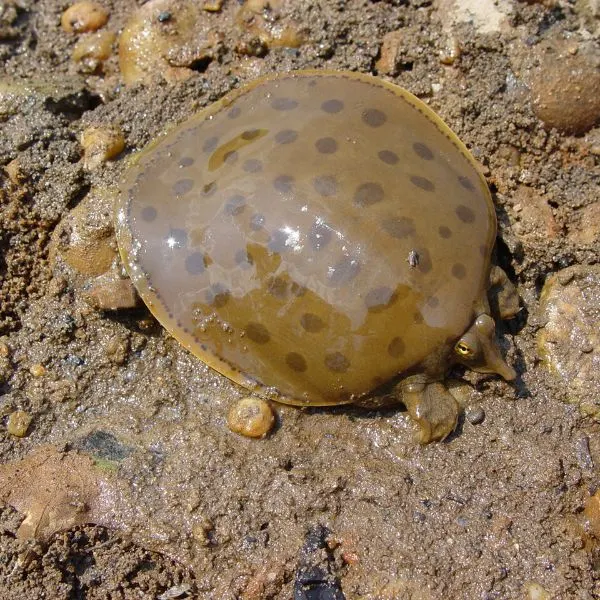
- Experience level: Intermediate
- Family: Trionychidae
- Scientific Name: Apalone calvata
- Other Names: N/A
- Average Adult Size: 5 – 15 inches
- Life Span: 25 – 50 years
- Average Price Range: $60 -$200
- Conservation Status: Least concern
Gulf Coast Smooth Softshell turtles resemble floppy manhole covers. They don’t have a hard shell like most turtles, instead, they have a smooth, flattened, rubbery carapace that doesn’t offer much protection from predators.
To protect themselves, they are very swift swimmers, and quick on land. They also have long necks, sharp beaks, and dangerous claws that can scratch or cut.
These turtles are almost all tan, to dark brown on the upper side, and lighter, or even white on the bottom. They have darker spots or splotches of color on their upper shell, and stripes that run from the pointed, pig-like snout to the back of the head.
In Mississippi, Smooth Softshell turtles are found in major river systems where the substrate is sandy and soft. Here they can camouflage themselves at the bottom and ambush prey. They are also great at active hunting as well.
Softshell turtles are mainly carnivores that feed on crayfish, fish, frogs, tadpoles, insects, and mollusks.
30. Gulf Coast Spiny Softshell
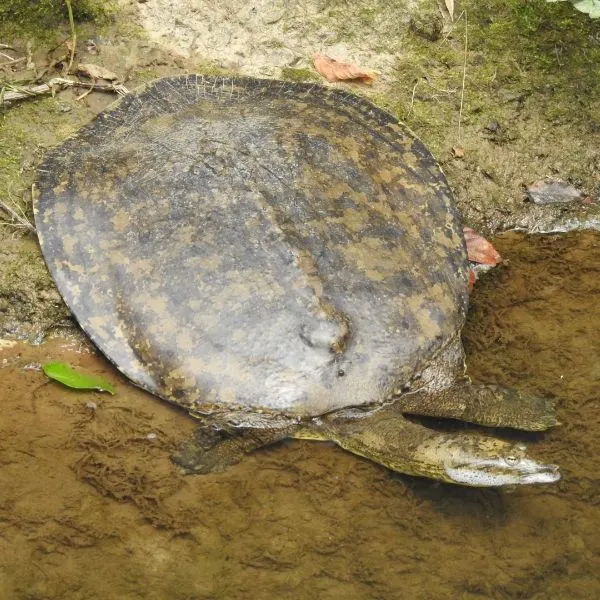
- Experience level: Intermediate
- Family: Trionychidae
- Scientific Name: Apalone spinifera aspera
- Other Names: N/A
- Average Adult Size: 5 – 19 inches
- Life Span: 25 – 50 years
- Average Price Range: approximately $60 – $200
- Conservation Status: Least concern
Gulf Coast Spiny Softshells are nearly identical to Gulf Coast Smooth Softshell turtles except for the bumpy, fleshy, nodules on the front half of the soft shell. With the flattened, soft, carapace, you can sometimes see the vertebrae and ribs on these turtles.
The Spiny Softshell turtle also grows larger than the smooth cousin. Extreme dimorphism comes into play in this species as well. Males are often half the size of the large females.
These turtles inhabit the same waters as the Smooth Softshell turtle, rivers, reservoirs, lakes, and large streams, preferably with strong currents.
These turtles are also mostly carnivorous, eating any aquatic insect, or small organism they can get into their mouths.
Tortoises in Mississippi
31. Gopher Tortoise
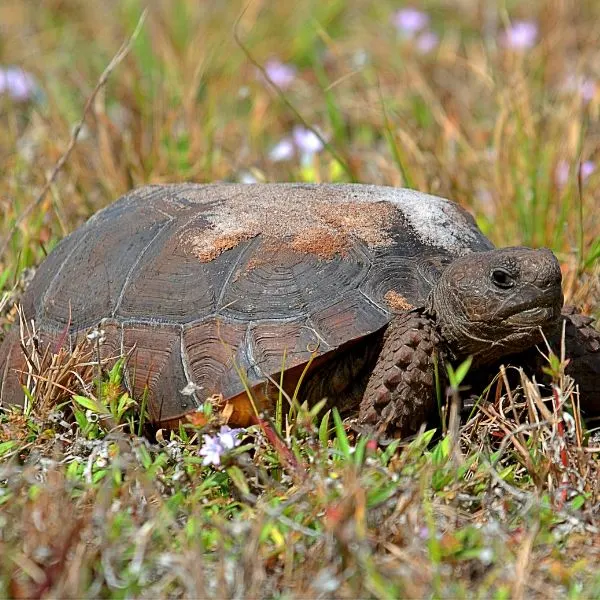
- Experience level: Intermediate
- Family: Testudinidae
- Scientific Name: Gopherus Polyphemus
- Other Names: Gopher turtle, Florida Gopher tortoise
- Average Adult Size: 9 – 15 inches
- Life Span: 40 – 60 years
- Average Price Range: Illegal to sell, but may be adopted with special permits
- Conservation Status: Threatened
The Gopher tortoise is the only tortoise species in Mississippi. These land dwelling turtles can not swim, and spend their lives on dry land, and in burrows.
Gopher tortoises have sandy brown, grey, or yellowish, highly domed carapaces. They have long necks, round heads, and miniature, elephant-like legs. Their front limbs have thick, prominent scales that aid in digging.
When it gets too hot or cold, Gopher tortoises will dig a long (up to 30 feet) and deep (usually 8 feet, but can be deeper) burrow to hide in. They will dig dozens of these dwellings over their lifetime that hundreds of other species rely on for protection and habitats.
It’s illegal to bother, touch, or take these turtles from the wild. It’s also illegal to damage or mess with their burrows because they are so important to other species.
Gopher tortoises are found in grasslands, pastures, prairies, and occasionally in your yard. If you happen to come across a wide, deep burrow on your property, it could be a gopher tortoise.
These slow moving tortoises are strict herbivores. They feed on native grasses, succulents such as cacti, fruits, berries, flowers, and other plants.
Sea Turtles in Mississippi
There are 7 species of sea turtles, all of which are endangered and federally protected in the United States. It is illegal to hunt, harm, or even touch them and their nests. They can’t be kept as pets, but in Mississippi, you might be able to see them off the coast, or a few may even nest on the sandy beaches.
Here are the 5 species that regularly visit the Gulf of Mexico.
32. Green Sea Turtle
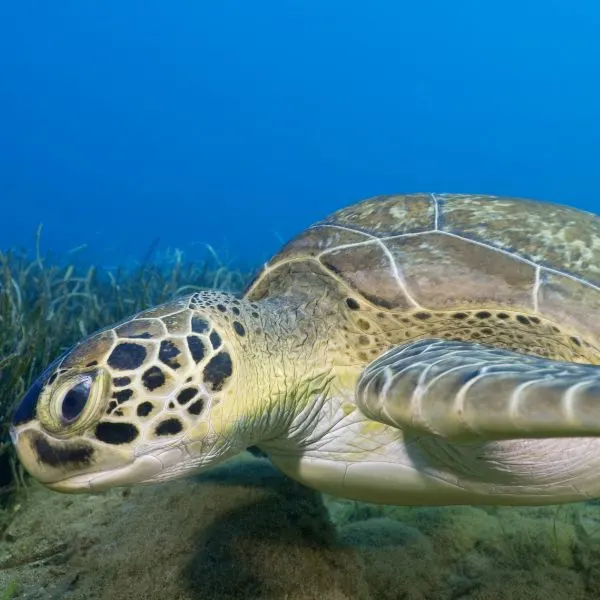
- Experience level: N/A, Illegal to own any sea turtle
- Family: Cheloniidae
- Scientific Name: Chelonia mydas
- Other Names: Green Sea Turtle
- Average Adult Size: 3 – 4 feet
- Life Span: 50 – 70 years
- Average Price Range: N/A
- Conservation Status: Endangered
Green Sea turtles tend to stay around tropical and temperate climates around the world. They often visit reefs, coastlines, and bays, and are rarely seen in the open ocean.
Green Sea turtles are a wide variety of colors. Their shell is a mix of browns, blacks, whites, greens, and olives. Their scales are green to black and are outlined in their skin color, from white to pale yellow.
They eat algae and sea grasses as adults, but juveniles eat a wide variety of plant matter and small living organisms such as crabs, fish, jellyfish, and krill.
33. Hawksbill Sea Turtle
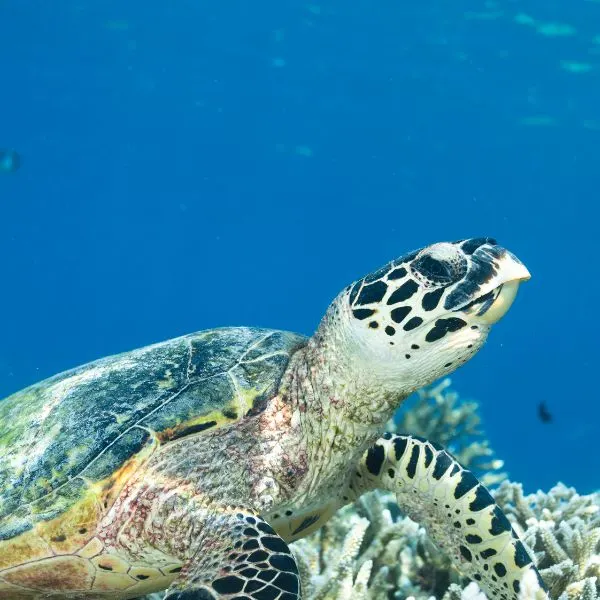
- Experience level: N/A, Illegal to own any sea turtle
- Family: Cheloniidae
- Scientific Name: Eretmochelys imbricata
- Other Names: Hawksbill
- Average Adult Size: 30 – 36 inches
- Life Span: 50 – 60 years
- Average Price Range: N/A
- Conservation Status: Critically endangered
Hawksbill Sea turtles eat mainly sea sponges and are often seen in coral reefs where sponges are prevalent. The Hawksbill has a sharp beak, is a smaller sea turtle, and has a beautifully marbled shell. Unfortunately, this gorgeous shell leads to many of them getting hunted.
In developing countries, the turtles are harvested, and the shell is processed to make guitar picks, glasses frames, hair accessories, lamps, and other “tortoiseshell” items.
34. Kemp’s Ridley Sea Turtle
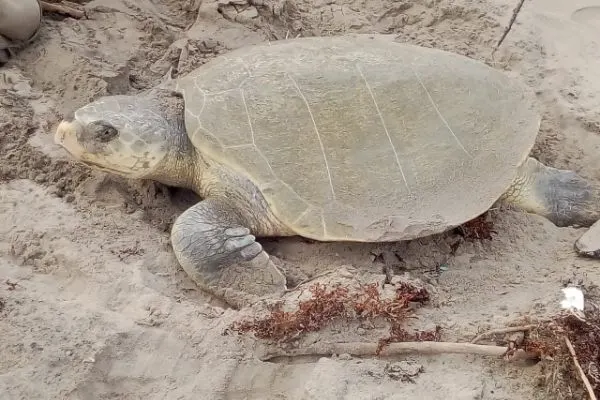
- Experience level: N/A, Illegal to own any sea turtle
- Family: Cheloniidae
- Scientific Name: Lepidochelys kempii
- Other Names: Atlantic Ridley, Tortuga Lora (Mexico)
- Average Adult Size: 24 – 27 inches
- Life Span: 30 years
- Average Price Range: N/A
- Conservation Status: Critically endangered
The Kemp’s Ridley Sea turtle is the smallest and most critically endangered of all species of Sea turtles. They are olive to purple on the top, and white to cream on the underside, and rarely exceed 2 feet in carapace length.
These turtles feed mainly on crabs and other crustaceans such as lobsters, and shrimp. Their preferred habitat is in the Gulf of Mexico, and they often surface around Louisiana and Mississippi, so there is a good chance you could see them bobbing around near the surface.
35. Leatherback Turtle
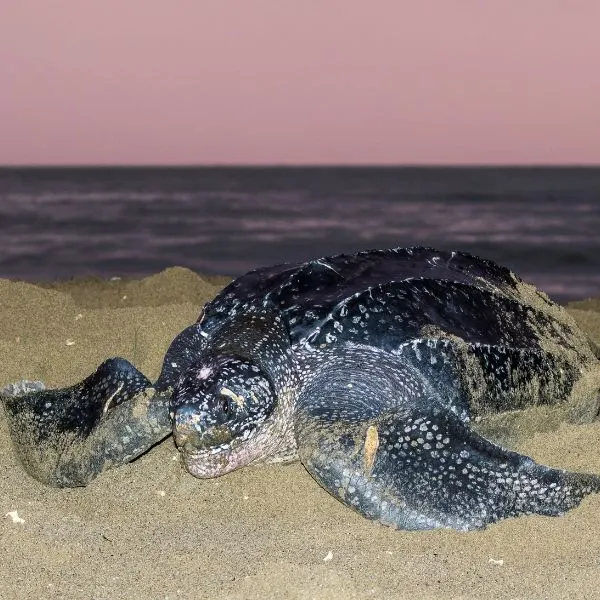
- Experience level: N/A, Illegal to own any sea turtle
- Family: Dermochelyidae
- Scientific Name: Dermochelys coriacea
- Other Names: Atlantic Leatherback, Leatherback
- Average Adult Size: 4 – 8 ft
- Life Span: 30 – 50 years
- Average Price Range: N/A
- Conservation Status: Endangered
Leatherback Sea turtles set all the records for turtles and sea turtles. They are the biggest turtles in the world, they don’t have a hard shell, they can dive the deepest of all turtles, they migrate farther than any other species, and they can withstand the coldest waters of all turtles.
These giants are dark, purplish-black, to black with light colored spots and a white underside. Their carapace is covered in bony plates and a thick, leathery skin. They have long front flippers and 7 ridges that run down the carapace.
While Leatherback Sea turtles are found all over the world, these will be the most scarce and hardest to spot. They spend most of their time in the open ocean following migrating schools of giant jellyfish—their main source of food.
These giant turtles nest on Atlantic coasts, but in Africa and the West Indies mostly.
36. Loggerhead Sea Turtle
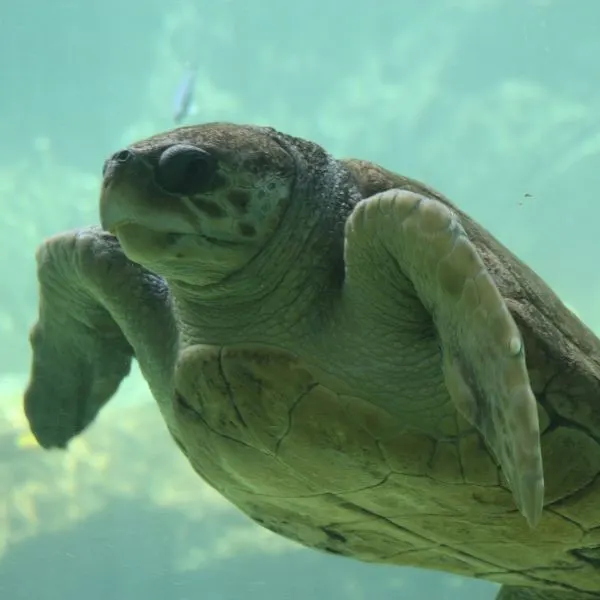
- Experience Level: N/A, Illegal to own any sea turtle
- Family: Cheloniidae
- Scientific Name: Caretta Caretta
- Other Names: Loggerhead
- Adult Size: 2.5 – 3.5 feet
- Life Span: 70 – 80 years
- Average Price Range: N/A
- Conservation Status: Endangered
Loggerhead Sea turtles have large, rounded heads compared to their body size that house extremely strong jaw muscles. These turtles are the largest, hard-shelled turtles in the world and have a reddish colored, somewhat heart-shaped shell.
Loggerhead Sea turtles are the most abundant species in the world and have recently started nesting in Mississippi sands.
They need such strong jaws to crack the tough shells of conch, whelks, and horseshoe crabs, their favorite foods.
FAQs
Are turtles illegal in Mississippi?
You can keep most types of turtles as long as you don’t take them from their wild habitats. In Mississippi, you cannot possess Alabama Red Belly turtles, Ringed Map turtles, Yellow-blotched Map turtles, or Gopher tortoises.
Can you buy a Gopher tortoise as a pet in Mississippi?
You can acquire a Gopher tortoise as a pet, but you have to get a special permit, and you either have to purchase a captive bred Gopher tortoise, or find a reptile sanctuary that will allow you to adopt one as a pet.
Are Alligator Snapping turtles protected in Mississippi?
Alligator Snapping turtles are protected in Mississippi, but you can take a wild one if you get a proper permit. After getting the permit, you are allowed one Alligator Snapping turtle per season, as long as the straight carapace length is at least 24 inches.
If you are looking for a pet, please try to purchase a captive bred specimen. Turtles taken from their natural habitats stress and die quickly, while captive bred turtles are used to a life as a pet and won’t stress in a properly maintained environment.
Be sure to consult the Mississippi Fish and Wildlife Department for more information on wild turtle possession.
Wrapping up
Hey! We’re glad to see you’ve stuck around to the end! We just went over 36 turtles you can see in the state, and off the coast of Mississippi.
As you can see, there is a huge variety of turtles here, from land dwelling Box turtles and Gopher tortoises to aquatic softshell and giant Alligator Snapping turtles. So whether you use this big guide as a herping checklist, or to choose your next great pet, we hope you enjoyed this journey with us.
If you did, feel free to leave us a comment below to tell us which turtle is your favorite and why, or just say hi.
Other nearby states
